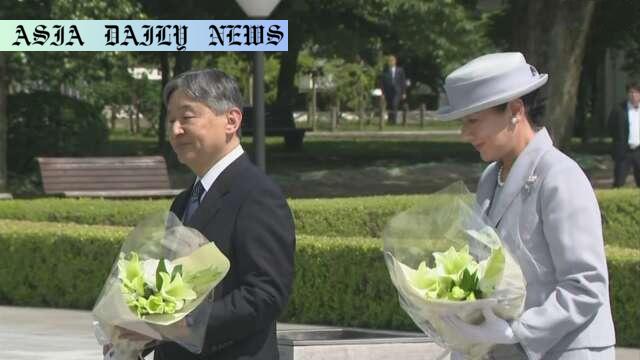Hiroshima: Emperor Naruhito and Empress Masako visited the Peace Memorial Park, paying respects to atomic bomb victims’ legacy.
- Hiroshima served as the focal point of the Emperor and Empress’s visit, marking deep remembrance of the atomic bombing victims.
- They visited the Peace Memorial Park and laid flowers to commemorate over 340,000 victims of radiation exposure.
- The visit included viewing damaged remnants and personal stories of war survivors in newly established exhibits.
- Replicas of the Nobel Peace Prize won by Nihon Hidankyo were acknowledged, highlighting the push for nuclear disarmament.

Emperor and Empress Pay Heartfelt Respect at Hiroshima
On their first visit to Hiroshima since he ascended the throne in 2019, Emperor Naruhito and Empress Masako paid a sombre and respectful tribute to the victims of one of history’s darkest chapters. Their two-day visit to the city, marking the 80th year since the end of World War II, brought a renewed sense of focus to the legacy left behind by the catastrophic atomic bombing of Hiroshima on August 6, 1945.
Honoring Lives Lost: The Peace Memorial Park Visit
The Peace Memorial Park provided a poignant setting for the Imperial couple’s tribute. Bowing their heads before the cenotaph and laying flowers, they paid their respects to the countless lives lost due to the bomb. This moment highlighted the importance of preserving such memories not just as a tribute to the fallen, but as a reminder of the devastating consequences of war.
The cenotaph stands as a powerful symbol of remembrance, containing a register of over 340,000 names of individuals exposed to radiation due to the bombing who later died. As the imperial couple stood there, the weight of history was more than evident.
A Painful Reflection: Witnessing the Aftermath
Later, the Emperor and Empress visited the Exhibit Facility for Atomic-Bombed Remnants, which opened three years ago in the park. The facility showcases remnants of houses destroyed by the bombing, standing as silent witnesses to the tragedy. Hearing stories about the loss of life in the neighborhood deeply moved the Emperor, who expressed the immense sorrow he felt over the destruction and pain borne by the community.
This reflective visit served to cast light on the long-lasting aftereffects of war, emphasizing the need to remember, learn from history, and honor both the victims and survivors who endured unimaginable suffering. These stories further highlighted not just the lives lost, but also the enduring resilience of the people of Hiroshima.
Recognizing Efforts for Nuclear Disarmament
In addition to revisiting the past, the visit carried a message of hope for the future. At the Hiroshima Peace Memorial Museum, the imperial couple acknowledged a significant step towards nuclear disarmament by observing replicas of the Nobel Peace Prize medal and certificate awarded to Nihon Hidankyo last year. The organization, comprising survivors of the atomic bombings, has been an active advocate for abolishing nuclear weapons and ensuring that such tragedies never occur again.
Their efforts have served as a beacon of hope and proof that resilience, combined with purposeful advocacy, can drive meaningful change. By honoring their achievements, Emperor Naruhito and Empress Masako reinforced the notion that true remembrance also involves building a future free from such threats.
Closing Chapters, Reflecting on the Future
The visit of the Emperor and Empress to Hiroshima was not merely ceremonial. It was an act of deep reflection and commitment to peace. With the 80th anniversary of the end of World War II approaching in 2025, this visit carries profound symbolic weight. It acknowledges the past while urging Japan and the global community to collectively strive for peace and reconciliation.
For Hiroshima, this visit reaffirms its role as a critical symbol of hope and resilience, reminding the world that humanity must continually work to overcome the shadows of its history.



Commentary
An Eternal Message from Hiroshima
The visit of Emperor Naruhito and Empress Masako to Hiroshima is both profound and inspiring. It serves as a reminder of the importance of acknowledging historical tragedies to foster a culture of peace. In the face of an increasingly turbulent geopolitical landscape, such gestures emphasize the enduring message of Hiroshima: never again.
The Ongoing Power of Memory
Hiroshima is more than a moment in history; it is an ongoing narrative of resilience and hope. By visiting the Peace Memorial Park and laying flowers at the cenotaph, the Emperor and Empress not only honored the victims but also contributed to keeping their memory alive. Each name inscribed in the register stands as a testament to lives lost needlessly to the horrors of war. The acknowledgment of these names by Japan’s highest figures is a bridge between the past and present, ensuring these lessons are never forgotten.
A Call to Action for Global Peace
This visit goes beyond remembrance—it is a call to the world. Hiroshima and its survivors, represented by groups like Nihon Hidankyo, have turned their grief into a call for peace and nuclear disarmament. The Emperor and Empress’s acknowledgment of the organization’s achievements underscores the importance of advocacy and the role nations must play in eliminating the threat of nuclear warfare. We must recognize the urgency of their mission amid the backdrop of global conflicts.
As we edge closer to the 80th anniversary of the end of World War II, Hiroshima reminds us to strive together for a better, more united world. By revisiting such chapters, we honor the past, affirm our present, and collectively work for a peaceful future.